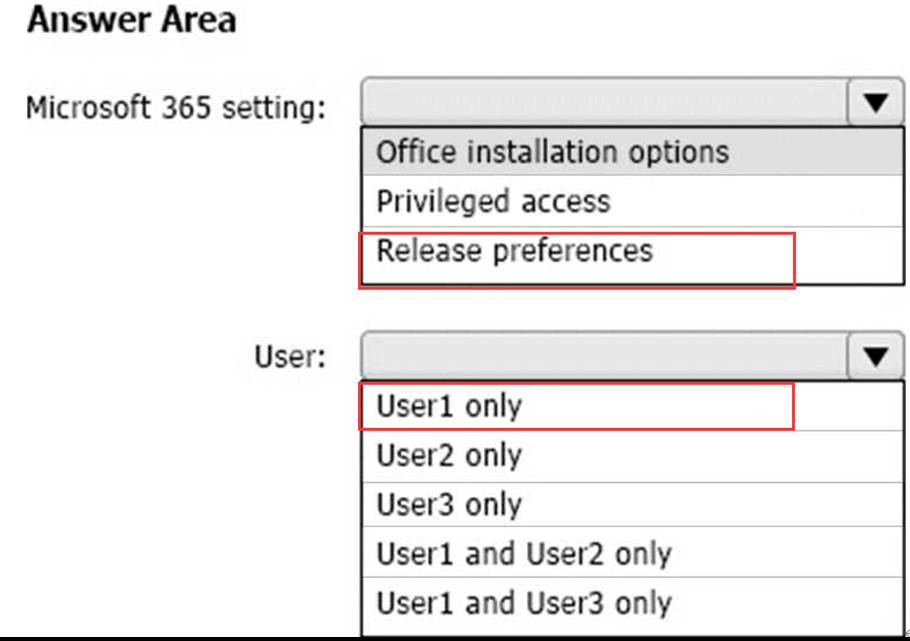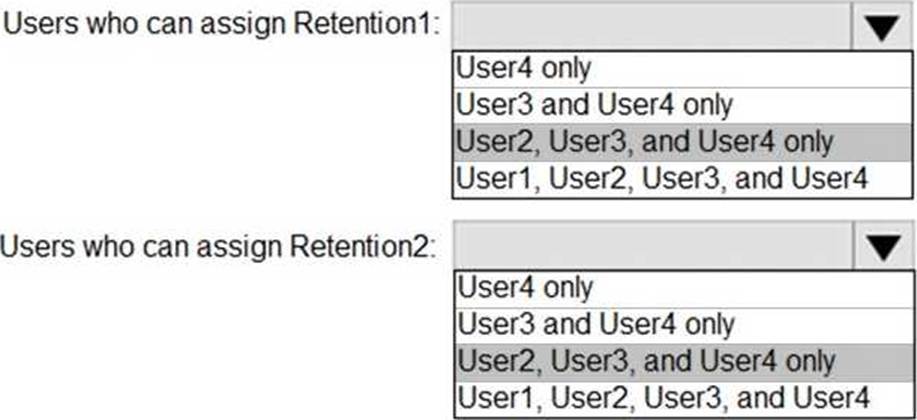Microsoft MS-102 Übungsprüfungen
Zuletzt aktualisiert am 26.04.2025- Prüfungscode: MS-102
- Prüfungsname: Microsoft 365 Administrator
- Zertifizierungsanbieter: Microsoft
- Zuletzt aktualisiert am: 26.04.2025
You have a Microsoft 365 E5 tenant that contains the devices shown in the following table.

You add custom apps to the private store in Microsoft Store Business.
You plan to create a policy to show only the private store in Microsoft Store for Business.
To which devices can the policy be applied?
- A . Device2 only
- B . Device1 and Device3 only
- C . Device2 and Device4 only
- D . Device2, Device3, and Device5 only
- E . Device1, Device2, Device3, Device4, and Device5
HOTSPOT
You have a Microsoft 365 E5 subscription that contains the users shown in the following table.
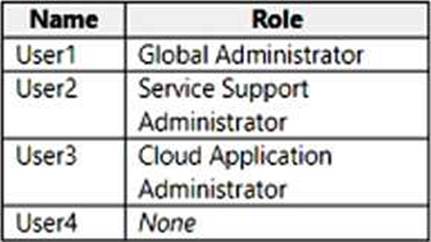
You plan to provide User4 with early access to Microsoft 365 feature and service updates.
You need to identify which Microsoft 365 setting must be configured, and which user can modify the setting. The solution must use the principle of least privilege.
What should you identify? To answer, select the appropriate options in the answer area. NOTE: Each correct selection is worth one point.

You have a Microsoft 365 subscription.
From Microsoft 365 Defender, you create a role group named US eDiscovery Managers by copying the eDiscovery Manager role group.
You need to ensure that the users in the new role group can only perform content searches of mailbox content for users in the United States.
Solution: From Windows PowerShell, you run the New-complianceSecurityFilter cmdlet with the appropriate parameters.
Does this meet the goal?
- A . Yes
- B . No
Note: This question is part of a series of questions that present the same scenario. Each question in the series contains a unique solution that might meet the stated goals. Some question sets might have more than one correct solution, while others might not have a correct solution.
After you answer a question in this section, you will NOT be able to return to it. As a result, these questions will not appear in the review screen.
Your network contains an on-premises Active Directory domain named contoso.com.
The domain contains the users shown in the following table.

The domain syncs to an Azure AD tenant named contoso.com as shown in the exhibit. (Click the Exhibit tab.)
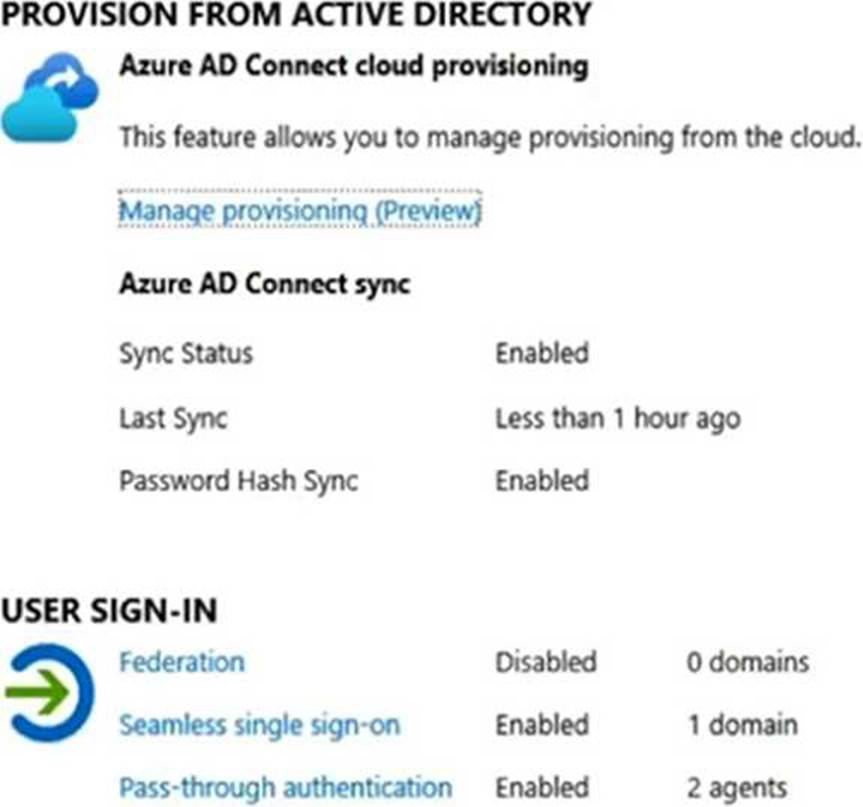
User2 fails to authenticate to Azure AD when signing in as [email protected].
You need to ensure that User2 can access the resources in Azure AD.
Solution: From the on-premises Active Directory domain, you set the UPN suffix for User2 to @contoso.com. You instruct User2 to sign in as [email protected].
Does this meet the goal?
- A . Yes
- B . No
HOTSPOT
You have a Microsoft 365 E5 subscription that contains the users shown in the following table.
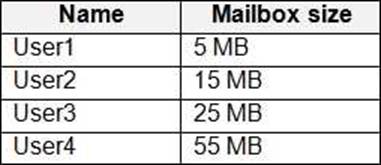
You have a Microsoft Office 365 retention label named Retention1 that is published to Exchange email.
You have a Microsoft Exchange Online retention policy that is applied to all mailboxes. The retention policy contains a retention tag named Retention2.
Which users can assign Retention1 and Retention2 to their emails? To answer, select the appropriate options in the answer area. NOTE: Each correct selection is worth one point.
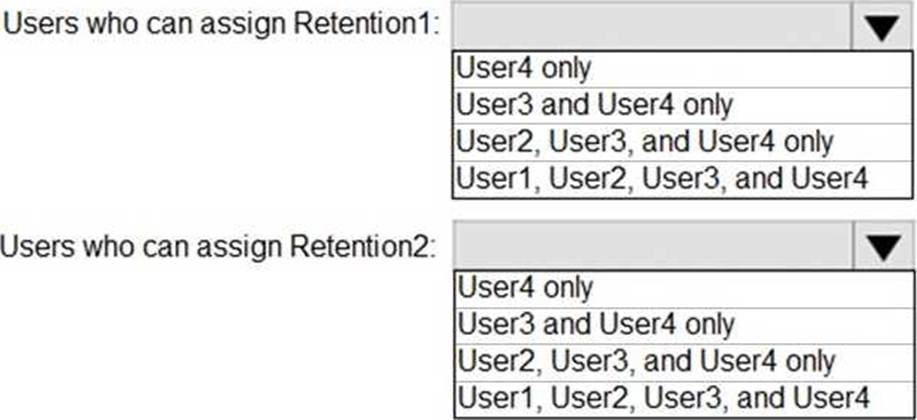
Your company has a Microsoft 365 E5 subscription.
Users in the research department work with sensitive data.
You need to prevent the research department users from accessing potentially unsafe websites by using hyperlinks embedded in email messages and documents. Users in other departments must not be restricted.
What should you do?
- A . Create a data loss prevention (DLP) policy that has a Content is shared condition.
- B . Modify the safe links policy Global settings.
- C . Create a data loss prevention (DLP) policy that has a Content contains condition.
- D . Create a new safe links policy.
You have a Microsoft 365 E5 subscription.
You need to compare the current Safe Links configuration to the Microsoft recommended configurations.
What should you use?
- A . Microsoft Purview
- B . Azure AD Identity Protection
- C . Microsoft Secure Score
- D . the configuration analyzer
Note: This question is part of a series of questions that present the same scenario. Each question in the series contains a unique solution that might meet the stated goals. Some question sets might have more than one correct solution, while others might not have a correct solution.
After you answer a question in this section, you will NOT be able to return to it. As a result, these questions will not appear in the review screen.
Your network contains an Active Directory domain named contoso.com that is synced to Microsoft Azure Active Directory (Azure AD).
You manage Windows 10 devices by using Microsoft System Center Configuration Manager (Current Branch).
You configure a pilot for co-management.
You add a new device named Device1 to the domain. You install the Configuration Manager client on Device1.
You need to ensure that you can manage Device1 by using Microsoft Intune and Configuration Manager.
Solution: Define a Configuration Manager device collection as the pilot collection. Add Device1 to the collection.
Does this meet the goal?
- A . Yes
- B . NO
Note: This question is part of a series of questions that present the same scenario. Each question in the series contains a unique solution that might meet the stated goals. Some question sets might have more than one correct solution, while others might not have a correct solution.
After you answer a question in this section, you will NOT be able to return to it. As a result, these questions will not appear in the review screen.
Your network contains an Active Directory domain named contoso.com that is synced to Microsoft Azure Active Directory (Azure AD).
You manage Windows 10 devices by using Microsoft System Center Configuration Manager (Current Branch).
You configure a pilot for co-management.
You add a new device named Device1 to the domain. You install the Configuration Manager client on Device1.
You need to ensure that you can manage Device1 by using Microsoft Intune and Configuration Manager.
Solution: Define a Configuration Manager device collection as the pilot collection. Add Device1 to the collection.
Does this meet the goal?
- A . Yes
- B . NO
You have a Microsoft 365 E5 subscription that uses Microsoft Defender for Endpoint.
You plan to perform device discovery and authenticated scans of network devices.
You install and register the network scanner on a device named Device1.
What should you do next?
- A . Connect Defender for Endpoint to Microsoft Intune.
- B . Apply for Microsoft Threat Experts – Targeted Attack Notifications.
- C . Create an assessment job.
- D . Download and run an onboarding package.

